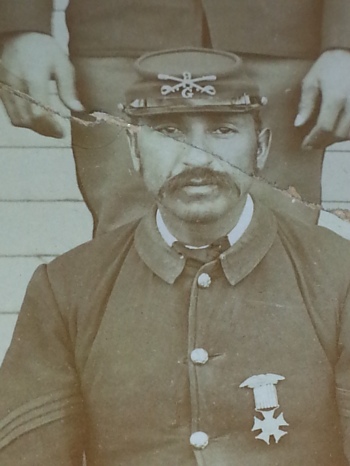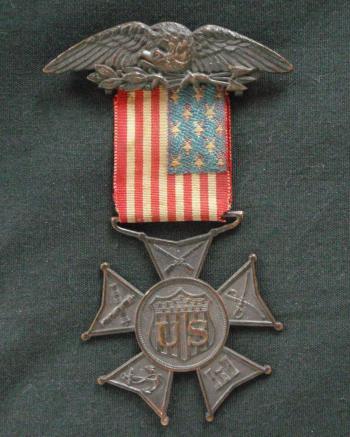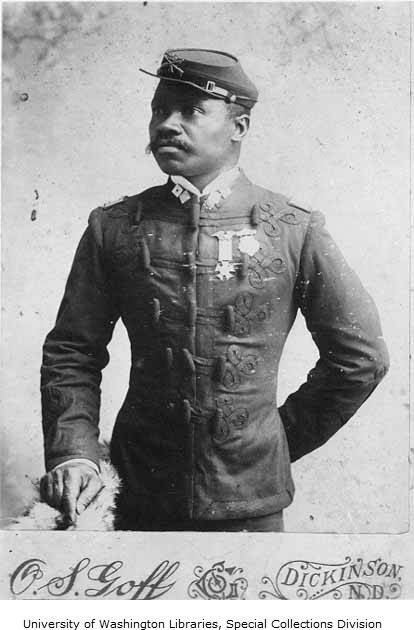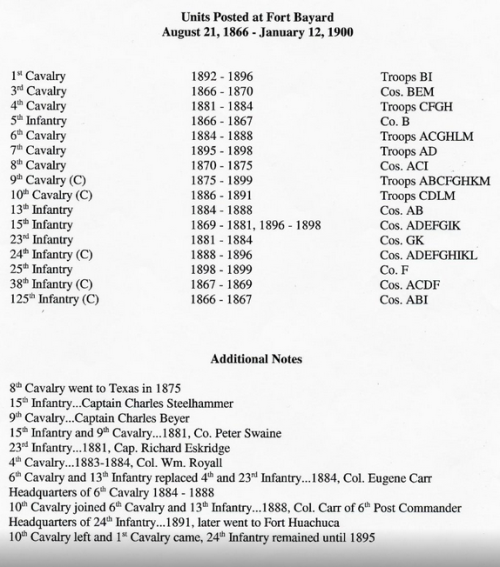The mystery continues! Compare the medal worn by one of our Mystery Soldiers and the featured Grand Army of the Republic (GAR) medal. Are they one in the same? And if yes, what does this tell us about their military service?
Now consider the medal (below) worn by this distinguished Buffalo Solider from Company A, 25th United States Infantry Regiment. Are we looking at the same medal and if so, what does that tell us?
Questions of the day:
- Did our Soldiers serve in the Civil or Indian War? Could they have served in both?
- Are the medals worn in fact GAR medals awarded for Marksmanship?
- Would soldiers in the Civil and Indian Wars have received the same type of medal?
- When and where was the picture taken? Could it have been Fort Bayard New Mexico? Checkout the Fort Bayard “porch” featured in this 1886 image. Is this the backdrop of our group photo? Buffalo Soldiers were stationed there and the 9th Cavalry unit was posted there from 1875-1899.
MANY thanks to my geneaholics (True and Bernita) and history/military buffs tossing their research eye into our search for answers. Kudos to Rick Romancito, TEMPO readers via Taos News and our new friends at the New Mexico Museum of History! Your contributions are keeping us very BUSY!:)
So stay tuned… looks like there will be lots more to come!:)
RESOURCES:
- Grand Army of the Republic – Wikipedia
- Fort Bayard Historic District (NM) – Wikipedia
- Units Posted at Fort Bayard 1866-1900 (below)




I love how so many people are chiming in to help solve this mystery. This men deserve to be honored and hopefully their descendants will find them.
Amazing right Bernita? The folks of Taos are working as hard as we are. These men have touched us all!
Reblogged this on You Got Roots?! and commented:
Still searching for the identity & story behind our Buffalo Soldier Mystery. Help us!:)
The medal five of the soldiers are wearing shows they are members of the Society of the Army and Navy Union of the United States. Badges of Military Societies were first authorized for wear in the 1897 Army Uniform Regulations. Typically uniform regulations served to catch up with what was already a common practice. Safe to say the photo is early to mid-1890s. The other badges are marksmanship badges. The two soldiers in the upper left are wearing sharpshooter badges (maltese cross) and the soldier second from the left is wearing a distinguished marksman badge. The solider with a cravat bottom row second from the right is wearing a marksman silver bar. All the soldiers are non-commissioned officers, six sergeants and four corporals. The soldier on the far right bottom row is wearing leggings and a old style plains cartridge belt which may indicate he paused from duties as corporal of the guard to join in the photo.
I can figure this photo out given some time.
Glad to see folks still care about our Buffalo Soldiers.
The leggings worn by the soldier in the front row far right were not adopted for wear by cavalrymen until 1894. Leggings replaced the traditional cavalry boots in that year. The photo had to be taken after 1894.
You are looking in the wrong place! The 9th Cavalry Regiment was stationed at Fort Robinson, Nebraska throughout the 1890s until deployed to Cuba in the War with Spain in 1898. Both Troop G and L were stationed at Ft Robinson all that time. There can be no doubt now as to where the photos were taken. Of significant interest is Charles Young, the second Black graduate of West Point, was the 2nd Lieut. of Troop L during this period. I will be able to identify the white officers in the Troop L baseball team picture, the soldiers will prove more challenging.
The names of the NCOs in the Troop G photo may appear on the regimental returns for the period. I will continue to dig.
Colonel Haenn, thank you for providing this information. We are learning so much about these soldiers and hopefully soon their names for their descendants.
Colonel help me understand what are the “regimental returns”? It would be amazing to connect Charles Young to our Troop L. Is there any historic writings of his that give insight into his leadership of the troop?
Luckie … your name has helped you hit pay dirt! Charles Young was assigned to Troop “G,” 9th Cavalry during his early distinguished military career. So our NCOs in the photo served under him and were without a doubt proud to be lead by a Black officer.
“Returns” are the written record/reports of military units and posts of the U.S. Army. they were maintained from the War of 1812 until 1916. Each company, troop, and battery made monthly returns to the regiment, accounting for the whereabouts of all assigned officers and soldiers. Each post made a monthly return to the War Department. These are the official records of events and strengths for each post and regiment in the Army. An invaluable source for historic documentation.
Quite a U.S. Army military lesson & history lesson I’ve been gifted Colonel. MANY thanks!:)
Thank you so much Colonel Haenn! Our Buffalo Soldier mystery gets more amazing by the day! I so appreciate the details you’re providing because therein lies our answers. Being able to isolate the time period of the picture & the Fort where they held post is HUGE. Clearly, it’s time to explore Fort Robinson. We look forward to your insights & once again, thank you for joining us in the effort to tell Troop G’s [and now, Troop L’s] story!
Dear Luckie,
If you are interested, I would like to send you three articles I wrote for our local paper in tribute to Black History Month. Our area is steeped in Black military history and the details just may amaze you. From Esteban (Black Stephen) the first documented African-American in the southwest in 1536, to Joe Lewis and Jackie Robinson in 1943 I feel no other place in America can match our legacy. Our county is the final resting place of four Black Medal of Honor recipients, more than any single location in the country. I hope with your help we can spread the good word.
Would love to see the articles Colonel Haenn! As you can see, I’m great at spreading the word! Until our Buffalo Soldiers arrived, my primary research/genealogy blog was http://OurGeorgiaRoots.com! I’ve been online since 1999 with historic research.
Dear Luckie,
How do I send the files to you?
Dear Luckie,
The file name for the Troop L photo IDs the group as being 10th Cavalry not the 9th, so we may have another mystery on our hands. The photo was taken on the porch of what appear to be officers’ quarters. The brick construction is clearly visible. If in fact this is “L” Troop 10th Cavalry I believe, based on the period of the military uniforms, the photo was taken at Fort Assinniboine, Montana in the late 1890s. This is the indeed the thrill of the hunt!
Hi Colonel Haenn! I too questioned the metadata included with the Troop L image received from the NM History Museum & included in “footnotes” the response of Archivist Hannah Abelbeck. There appears to be a “Troop L” in both the 9th & 10th Cavalry — indeed adding a NEW factor into our mystery! My thought is if we can identify the white officers & the Forts where the pictures were taken, we’re closer to nailing down the particulars around service. And I along with Bernita, do hope this leads us to naming these honorable servicemen. Exciting times!:)
I am confident the soldiers are from Troop “L” 10th Cavalry.
I believe the officer on the left to be the Troop Commander, Captain Richard Henry Pratt. He commanded the Troop for over 14 years from 1883-1898. Pratt rose through the ranks in the Civil War and was mustered out in May 1865 as a captain in the 11th Indiana Cavalry. He was assigned as a 2nd Lieut. in the 10th Cavalry in March 1867. So he spent over 30 years in the regiment. He retired as the Colonel of the 13th Cavalry, 17 Feb 1903.
I believe the other officer is 1st Lieut. William Ewen Shipp, United States Military Academy Class of 1883. Shipp was assigned to the 10th Cavalry upon his graduation from West Point. He was promoted to 1st Lieut. on Christmas Day 1889. Shipp was killed in action on July 1, 1898 during the 10th Cavalry’s charge up San Juan Hill, Cuba in the War with Spain.
Additionally Colonel Haenn, your “Friends of the Fort Clark Historic District” website (http://www.ffchd.org) is a wealth of information. I’m adding it to our Military References pronto!
Dear Luckie,
In all likelihood the soldier baseball players in the photo charged up San Juan Hill on July 1, 1898. Perhaps some were wounded or killed. The “Rough Riders” got the glory but it was the Buffalo Soldiers who won the day.
Absolutely amazing Colonel Haenn! The metadata attached to the Troop L image cited the photo being taken in 1899 but as noted, these details came from the dealer who brokered the images. I agree, the officer on the right does resemble images of Lieut. Shipp.
Luckie… Fascinating photograph, and so glad you shared it here. If you’ve not read it yet, the original history of the 9th Cavalry, written about 1895, is available on line. It was written by the regimental adjutant, Lieutenant Grote Hutcheson, and was included as a chapter in the book “The Army of the United States, Historical Sketches of the Staff and Line.”
http://www.history.army.mil/books/R&H/R&H-9CV.htm
Coincidentally, Lieut. Hutcheson commanded, at least briefly, G Troop, 9th Cav., during the Pine Ridge Campaign of November 1890 – January 1891. If LTC (Ret) Haenn is correct on the time period of the photograph–and I believe he is spot on–the troopers in your photo likely participated in that campaign. Named for their commander, Major and brevet Colonel Guy V. Henry–perhaps the most renowned Indian fighter in uniform at the time–the 9th Cavalry during that campaign were dubbed “Henry’s Brunettes.”
A 26 Jan 1891 article in the Omaha Bee, detailed Major General Nelson A. Miles’ review of all the soldiers gathered in Pine Ridge at the end of the campaign. Following is the section on the 9th Cavalry.
“Then came the Ninth, the fame of which in this campaign is the subject of general conversation. In a certain sense it was the leading feature of the parade. The troopers are colored. They wore buffalo overcoats. Long or short, light or heavy, they sat there on horses like Neys. They seemed to glory in the soldier’s life, to take to it as kindly as do the savages to the warpath. They looked like Esquimaux rigged out for an active campaign and demeaned themselves as if they were alike fearless of the elements and storms of shot and shell. At their head rode Colonel Henry, the fearless man who has led them in their rides over these hills and valleys and both into and out of the mouth of hell, which they have experienced on several occasions. Lieutenant W. Finley acted as adjutant, Dr. Kane as medical officer and Lieutenant Bettens as quartermaster.
“The First battalion was commanded by Captain Loud, A troop by Captain Garrard, I troop by Lieutenant Perry, G troop by Lieutenant Grote Hutcheson, in the absence of the veteran Captain Cusack, who was seriously ill. The guidon of this troop was badly punctured with bullets.
“The Second Battalion was commanded by Captain Stedman, K troop being led by “Light-Horse Harry,” Captain Wright, the young gentleman who has just received the spurs of his present rank which even was celebrated on the field of battle. F troop was led by Lieutenant McAnany and D troop by Lieutenant Powell. A Hotchkiss battery brought up the rear.”
A more famous narrative of General Miles’ review appeared in Harper’s Weekly:
“…..And when the black scowling faces of the Ninth Cavalry passed in close lines behind the glittering carbines held at a salute, General Miles waved his gloved hand to Colonel Henry, whose gaunt figure was almost lost in the folds of his buffalo overcoat. Three weeks before, these black troopers rode 100 miles without food or sleep to save the Seventh cavalrymen, who were slowly being crushed by the Sioux in the valley at the Catholic Mission. Then they dashed through the flanks of the savages, and after sweeping the ridges with carbine and pistol, lifted the white troopers out of the pocket with such grace that after the battle was over the men of both regiments hugged one
another on the field.”
Henry later wrote a detailed account of the 9th Cavalry’s famous 100-mile ride during that campaign that culminated with the rescue of the 7th Cavalry at the Drexel Mission fight on White Clay Creek, 30 Dec. 1890. If interested, I can post a copy of Henry’s narrative.
Colonel Russell I am in awe of the history & service of these men! I too believe Colonel Haenn’s analysis to be spot-on & have been busy following-up on all the leads shared. As a historian & genealogist documenting every possible detail is vital. We’re still hoping to identify the names of our soldiers. I can only imagine the pride their living descendants would feel learning about their Ancestors courage in battle. Thanks to you & Colonel Haenn for bringing your knowledge & understanding of Buffalo Soldier history to this forum. It has proved invaluable.
Luckie… I hope you don’t mind that I republished the photograph on my blog. I do give you and the Taos News credit, and quote several of LTC Haenn’s outstanding comments.
I also included General Guy V. Henry’s account of the 9th Cavalry at Pine Ridge in 1890-91 under his command.
Pingback: Henry’s Brunettes | Army at Wounded Knee
Luckie and COL Russell … In another remarkable coincidence of history the soldier ballplayers of L Troop, 10th Cavalry could not only pride themselves in having charged up San Juan Hill ahead of the Rough Riders but they could also lay claim that their lieutenant until September 1895 was none other than John J. Pershing.
Pingback: 9th & 10th Cavalry: Setting Our Sight on Fort Robinson | Where Honor Is Due: Our Men of Military Service
Luckie … here are the names of some of the NCOs who served in G Troop, 9th Cavalry during the period 1895-1898. The names are recorded in the regimental returns for the 9th cavalry held by the National Archives and available on Ancestry.com. Although this does not ID any individual in the photo it is certainly a start. Since soldiers served in the same troop sometimes for their entire Army career it is safe to say these soldiers saw long time service in Troop “G.”
1SG CHARLES GOODLOW
CPL JOHN L. GREGG
CPL JACKSON LEWIS
SGT JOHN E. MILLER
SGT JOHN E. OGLESBY
SGT ARTHUR E. RANSOM
SGT WILLIAM STANTON
SGT WILLIAM A. VROOMAN
SGT A. P. WINFIELD
I’m simply speechless. To call any of their names is paying tribute to the whole. Wow.
This is wonderful. We just got the headstone for our Buffalo Soldier ancestor that was in an unmarked grave for over eighty years. Best Regards from Maman Jeanne and Daughter
Wow this is so cool and I live 3 miles from fort Bayard. I went metaldetecting in the forest Sunday and I found some of there bullet casings and A button off of there uniform super cool find